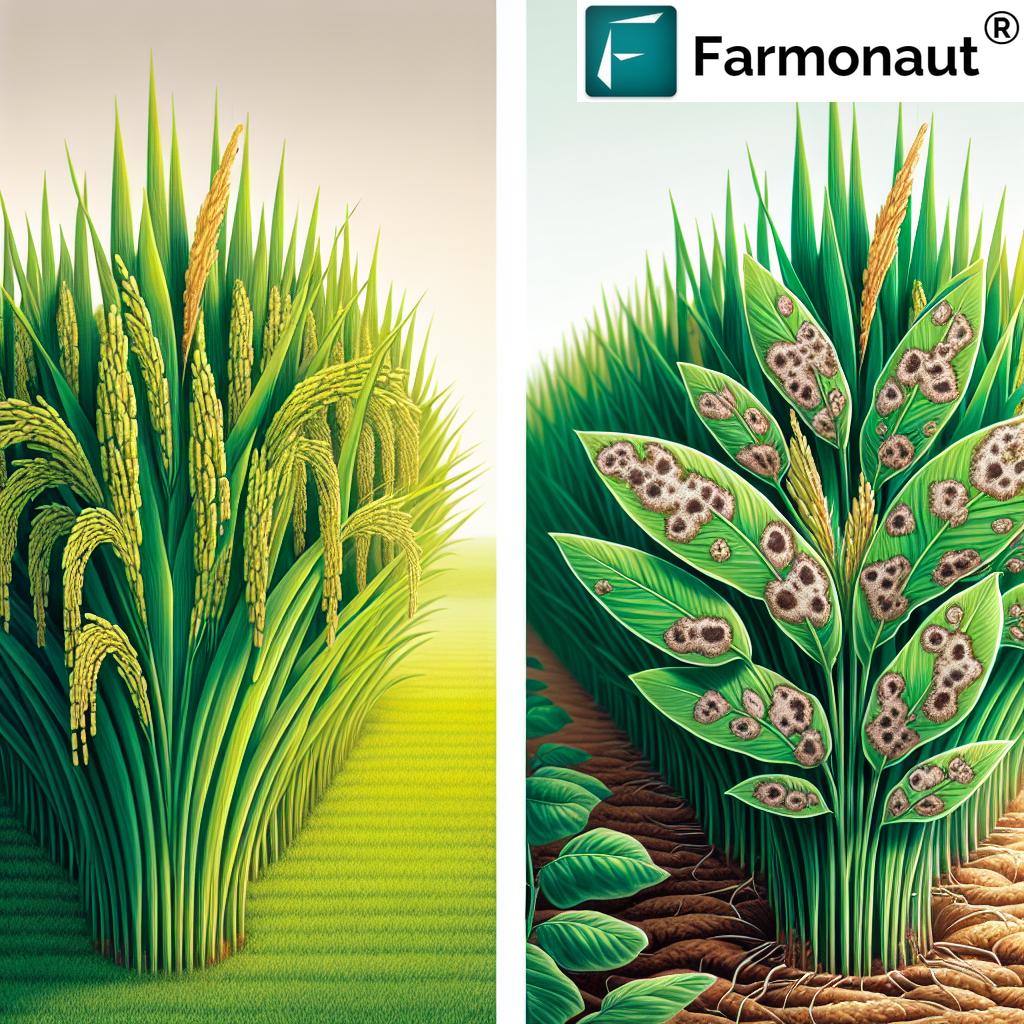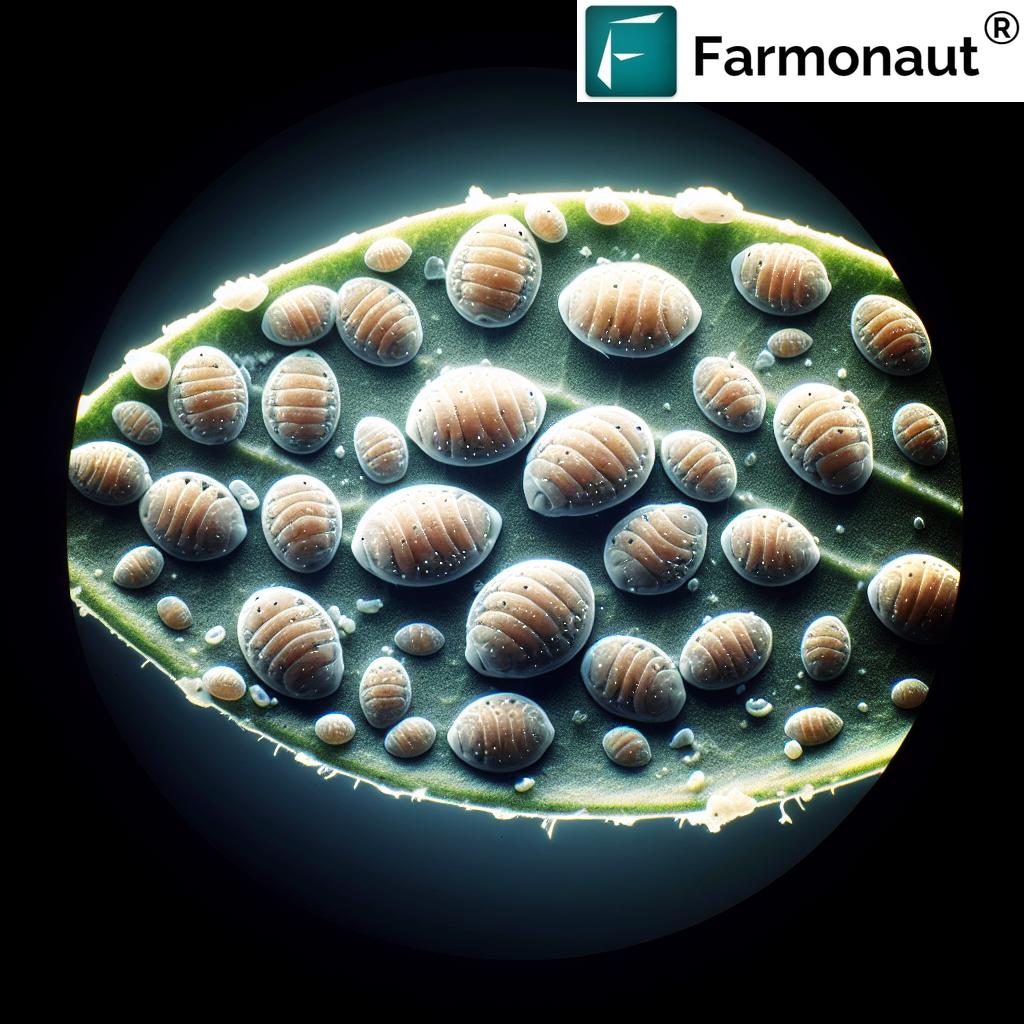Organic Rice Disease Management: Identifying Symptoms and Controlling Fungal Infections

In the world of agriculture, rice stands as one of the most important crops globally, feeding billions of people every day. However, like all plants, rice is susceptible to various diseases that can significantly impact yields and farmer livelihoods. As advocates for sustainable farming practices, we at Farmonaut are committed to helping farmers identify and manage these diseases effectively, with a particular focus on organic methods. In this comprehensive guide, we’ll delve into the world of rice diseases, their symptoms, and organic management strategies, with a special emphasis on the notorious rice blast disease caused by the fungus Magnaporthe oryzae.
Understanding Rice Diseases
Rice plants can be affected by numerous diseases, but fungal infections are among the most common and destructive. These diseases can attack various parts of the plant, including leaves, stems, roots, and panicles, leading to reduced grain quality and yield losses. Some of the most prevalent rice diseases include:
- Rice Blast (caused by Magnaporthe oryzae)
- Sheath Blight
- Brown Spot
- Bacterial Leaf Blight
- False Smut
Among these, rice blast deserves special attention due to its widespread occurrence and potential for severe crop damage.
Rice Blast: A Closer Look
Rice blast, caused by the fungus Magnaporthe oryzae, is one of the most devastating rice diseases worldwide. It can affect all above-ground parts of the rice plant, including leaves, neck, nodes, panicles, and even grains. The disease can cause yield losses of up to 70-80% in severe cases, making it a significant threat to food security in rice-growing regions.
Symptoms of Rice Blast
Identifying the symptoms of rice blast early is crucial for effective management. Here are the key signs to look out for:
- Leaf Blast: This is often the first visible sign of infection. Look for diamond-shaped lesions with gray centers and dark borders on the leaves. These spots can enlarge and coalesce, causing entire leaves to wither and die.
- Neck Blast: Infection of the neck (the topmost internode of the rice plant) is particularly damaging. Look for a brown to black discoloration at the base of the panicle. Severe neck blast can cause the entire panicle to dry up, resulting in significant yield loss.
- Node Blast: Dark brown to black lesions on the nodes can cause the culm to break, leading to lodging of the plant.
- Panicle Blast: Infected panicles may appear white or gray and remain upright due to their light weight. Partially filled or empty grains are common symptoms.
Life Cycle of the Rice Blast Fungus
Understanding the life cycle of Magnaporthe oryzae is essential for developing effective control strategies. The disease cycle typically involves the following stages:
- Survival: The fungus survives between cropping seasons on rice stubble, volunteer rice plants, and alternative hosts.
- Spore Production: Under favorable conditions (high humidity and temperatures between 20-30°C), the fungus produces spores called conidia.
- Dispersal: Conidia are dispersed by wind or water splash to nearby plants.
- Infection: When conidia land on a susceptible rice plant, they germinate and penetrate the plant tissue, initiating an infection.
- Symptom Development: After a latent period of 5-7 days, visible symptoms appear on the infected plant parts.
- Secondary Spread: New spores are produced on the lesions, leading to further infections and disease spread.
Organic Management Strategies for Rice Blast
At Farmonaut, we believe in promoting sustainable and organic farming practices. Here are some effective organic strategies for managing rice blast:
1. Cultural Control Methods
- Crop Rotation: Rotate rice with non-host crops to break the disease cycle.
- Field Sanitation: Remove and destroy crop residues to reduce inoculum sources.
- Water Management: Maintain proper water levels in the field to reduce humidity and create less favorable conditions for fungal growth.
- Nutrient Management: Avoid excessive nitrogen application, as it can increase plant susceptibility to blast.
- Planting Time: Adjust planting dates to avoid periods of high disease pressure.
2. Resistant Varieties
Using rice varieties with genetic resistance to blast is one of the most effective and environmentally friendly control methods. Work with local agricultural extension services to identify resistant varieties suitable for your region.
3. Biological Control
Several beneficial microorganisms have shown promise in suppressing rice blast. These include:
- Trichoderma species
- Bacillus subtilis
- Pseudomonas fluorescens
These biocontrol agents can be applied as seed treatments or foliar sprays.
4. Organic Fungicides
While organic farming aims to minimize the use of external inputs, certain organic fungicides can be used as a last resort for disease control. Some options include:
- Copper-based fungicides (use with caution to avoid soil accumulation)
- Sulfur-based products
- Neem oil
- Potassium bicarbonate
Always follow label instructions and local regulations when using any pest control products.
5. Plant Extracts and Botanicals
Various plant extracts have shown antifungal properties against rice blast. These include:
- Garlic extract
- Ginger extract
- Eucalyptus oil
- Citrus extracts
While these can be effective, their use may require multiple applications and careful timing.
Integrated Disease Management Approach
At Farmonaut, we advocate for an integrated approach to disease management that combines various organic methods. This holistic strategy not only helps control rice blast but also promotes overall plant health and ecosystem balance. Here’s how you can implement an integrated approach:
- Prevention: Start with clean, certified seeds and resistant varieties. Implement good field hygiene practices.
- Monitoring: Regularly scout your fields for early signs of disease. Our satellite-based crop monitoring system can help detect anomalies in crop health across large areas.
- Cultural Practices: Implement the cultural control methods mentioned earlier, such as proper water and nutrient management.
- Biological Control: Use beneficial microorganisms as a preventive measure and to boost plant immunity.
- Organic Treatments: Apply organic fungicides or plant extracts when necessary, based on disease pressure and weather conditions.
- Post-Harvest Management: Properly dispose of crop residues to reduce inoculum for the next season.
The Role of Technology in Disease Management
At Farmonaut, we leverage advanced technology to enhance disease management strategies. Our satellite-based crop monitoring system offers several advantages over traditional scouting methods:
| Aspect | Traditional Scouting | Farmonaut’s Satellite-Based System |
|---|---|---|
| Speed | Time-consuming, manual process | Rapid, automated monitoring |
| Accuracy | Subject to human error | High precision through multispectral imaging |
| Coverage Area | Limited to accessible areas | Comprehensive coverage of entire fields |
| Early Detection | May miss early symptoms | Capable of detecting stress before visible symptoms appear |
Our technology allows farmers to:
- Detect crop stress early, often before visible symptoms appear
- Monitor large areas efficiently
- Receive alerts for potential disease outbreaks
- Make data-driven decisions for timely interventions
To learn more about how our satellite-based monitoring can help you manage rice diseases more effectively, visit our app or explore our API services.
Case Studies: Successful Organic Rice Blast Management
While we don’t include specific case studies or success stories, it’s worth noting that many farmers around the world have successfully implemented organic rice blast management strategies. These approaches often combine resistant varieties, cultural practices, and biological control methods to achieve effective disease suppression while maintaining soil health and ecosystem balance.
Future Perspectives in Organic Rice Disease Management
The field of organic rice disease management is continually evolving. Some promising areas of research and development include:
- Development of new, more resistant rice varieties through traditional breeding and marker-assisted selection
- Exploration of novel biocontrol agents and their formulations
- Advancements in precision agriculture and remote sensing for early disease detection
- Investigation of plant-microbe interactions to enhance natural plant defenses
- Development of more effective organic fungicides and plant-based treatments
At Farmonaut, we’re committed to staying at the forefront of these developments and incorporating new knowledge into our advisory services and technological solutions.
Frequently Asked Questions (FAQ)
-
Q: How can I distinguish rice blast from other rice diseases?
A: Rice blast typically produces diamond-shaped lesions with gray centers on leaves, while other diseases may have different patterns. Neck blast causes distinctive brown to black discoloration at the base of the panicle. -
Q: Are there any natural predators of the rice blast fungus?
A: While there are no specific predators of the fungus itself, certain beneficial microorganisms can compete with or inhibit its growth. These include various species of Trichoderma and Bacillus. -
Q: How often should I scout my rice fields for blast symptoms?
A: Regular scouting, at least once a week, is recommended during the growing season. Increase frequency during periods of high humidity or after rain events. -
Q: Can rice blast spread to other crops?
A: While rice blast primarily affects rice, some strains can infect other grass species. However, crop rotation with non-grass crops is still an effective management strategy. -
Q: How does climate change affect rice blast incidence?
A: Climate change can potentially increase rice blast incidence by altering temperature and humidity patterns. This makes proactive management and monitoring even more crucial.
Conclusion
Managing rice blast and other rice diseases organically requires a comprehensive, integrated approach. By combining resistant varieties, cultural practices, biological control, and judicious use of organic treatments, farmers can effectively protect their crops while maintaining environmental sustainability. At Farmonaut, we’re dedicated to supporting farmers in this endeavor through our advanced satellite-based monitoring systems and expert advisory services.
Remember, successful disease management starts with vigilance and early detection. Our technology can help you stay one step ahead of potential outbreaks, allowing for timely interventions and optimal crop protection. To learn more about how Farmonaut can support your organic rice farming efforts, visit our website or download our app:
For developers interested in integrating our satellite and weather data into their own systems, check out our API documentation.
Together, we can work towards a future of sustainable, productive, and disease-resilient rice cultivation.

Subscribe to Farmonaut Services













